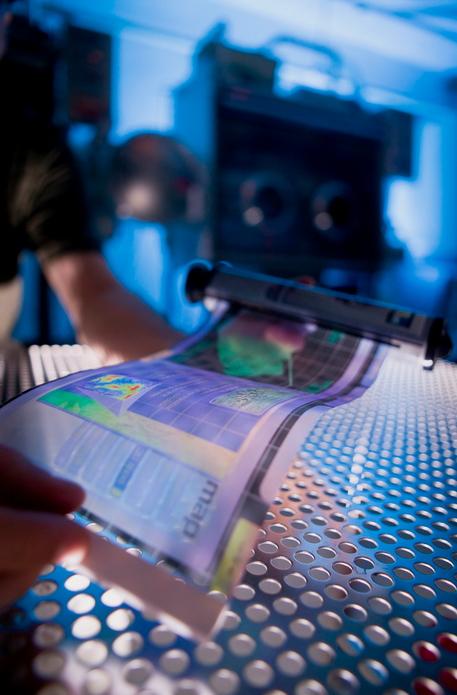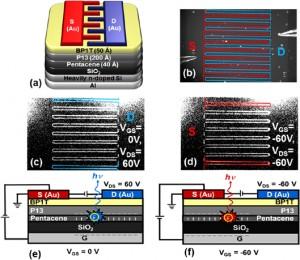Organic Field-Effect Transistors (OFETs) were originally developed to produce extremely low-cost, large-area electronics aimed at producing printable and flexible electronic devices.
Researchers at Japan’s National Institute for Materials Science say improvements are now in the offing that will allow for the manufacture of transistors which can be used to make highly flexible and paper-thin computer screens and displays.
 They’re also sure to find applications in the world of 3D printing.
They’re also sure to find applications in the world of 3D printing.
These photoactive organic field-effect transistors incorporate organic semi-conductors, can amplify weak electronic signals, and then either emit or receive light. And since their appearance on the scene in 2003, researchers say that enormous steps forward have been made in the development of one variant: light-emitting organic field-effect transistors (LE-OFETs).
 The photoactive OFETs are divided into two types; light-emitting (LE) and light-receiving (LR) OFETs. They are categorized according to functionality. The devices can function as non-volatile optical memories, phototransistors, and photochromism-based transistors.
The photoactive OFETs are divided into two types; light-emitting (LE) and light-receiving (LR) OFETs. They are categorized according to functionality. The devices can function as non-volatile optical memories, phototransistors, and photochromism-based transistors.
In both cases a variety of configurations can produce devices like thin-film based transistors for practical applications and nanowiring.
And here’s where the technology gets truly interesting. Light-receiving organic field-effect transistors will break new ground for photonic and electronic devices and result in the creation of flexible displays where all the various device components (light-emitting elements, switching parts and the substrates) – are made of plastic materials.
For the most part, plastic materials mean “3D printable” materials.
As those materials have already been created and are expected to appear on the market in the near term, LE-OFETs are thought to be completely compatible with existing and popular electronic technologies.
 The Japanese researchers say the performance of devices which incorporate both light-emitting and light-receiving transistors is currently hampered by a number of issues, and that collaborative effort among organic chemists and device physicists will be required to resolve those stumbling blocks.
The Japanese researchers say the performance of devices which incorporate both light-emitting and light-receiving transistors is currently hampered by a number of issues, and that collaborative effort among organic chemists and device physicists will be required to resolve those stumbling blocks.
While the team say it may take ten years before all-plastic and highly flexible computing devices appear on the market, the technology is already attracting interest from a wide range of interested parties.
Yutaka Wakayama of the International Center for Materials Nanoarchitectonics (WPI-MANA) and the National Institute for Materials Science (NIMS) worked in conjunction with Ryoma Hayakawa and Hoon-Seok Seo on the research.
Can you see applications of OFET technology in the 3D printing sphere? Let us know your thoughts in the 3D Printed Flexible Computer forum thread on 3DPB.com.
Subscribe to Our Email Newsletter
Stay up-to-date on all the latest news from the 3D printing industry and receive information and offers from third party vendors.
You May Also Like
Gorilla Sports GE’s First 3D Printed Titanium Cast
How do you help a gorilla with a broken arm? Sounds like the start of a bad joke a zookeeper might tell, but it’s an actual dilemma recently faced by...
Nylon 3D Printed Parts Made More Functional with Coatings & Colors
Parts 3D printed from polyamide (PA, Nylon) 12 using powder bed fusion (PBF) are a mainstay in the additive manufacturing (AM) industry. While post-finishing processes have improved the porosity of...
$25M to Back Sintavia’s Largest Expansion of Metal 3D Printing Capacity Since 2019
Sintavia, the digital manufacturing company specializing in mission-critical parts for strategic sectors, announced a $25 million investment to increase its production capacity, the largest expansion to its operations since 2019....
Velo3D Initiates Public Offering in a Bid to Strengthen Financial Foundations and Drive Future Growth
Velo3D (NYSE: VLD) has been among a number of publicly traded 3D printing firms that have attempted to weather the current macroeconomic climate. After posting a challenging financial report for 2023,...































